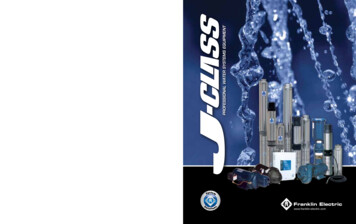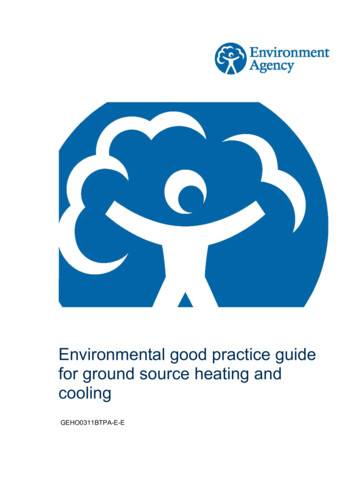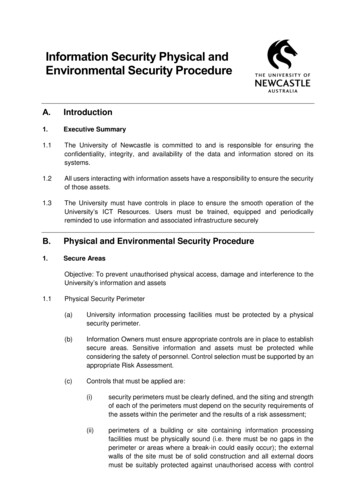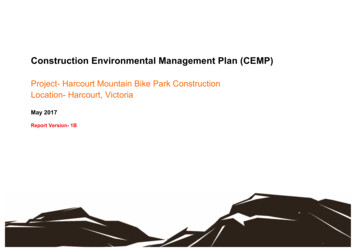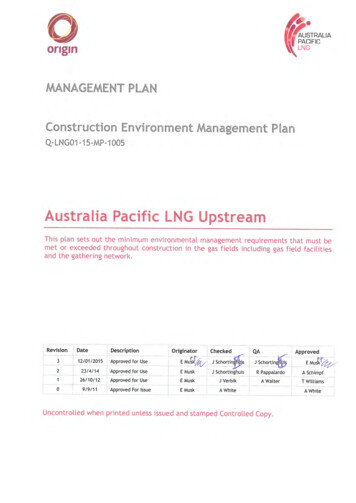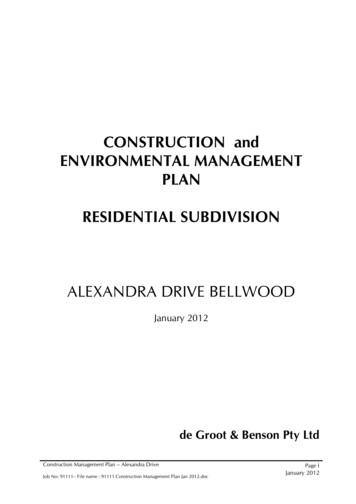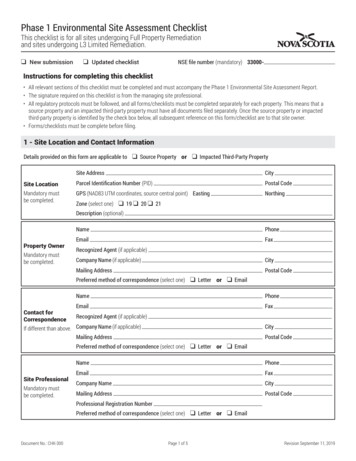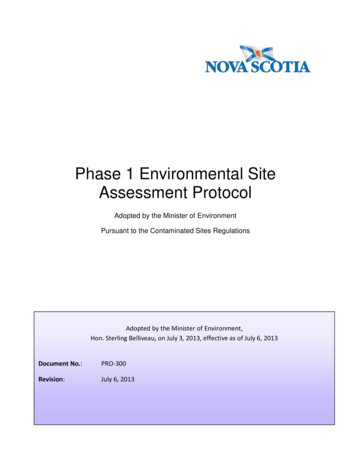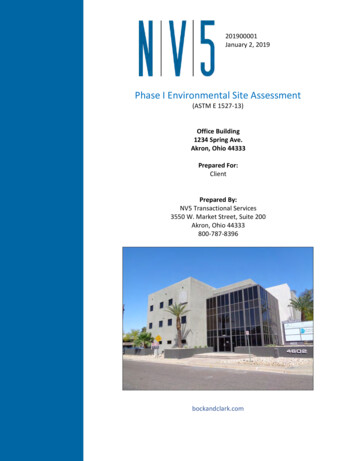
Transcription
The Environmental Professional’sGuide to Lean & Six Sigmawww.epa.gov/lean
Lean and Chemicals ToolkitHow to Use This ToolkitThis guide uses icons in the page margins to help you find andfollow important information.Identifies an important point to rememberKey PointDefines an important term or conceptKey TermPresents a technique or resource that helps capture,communicate, or apply new knowledgeNew ToolDescribes sequenced actionsHow-To StepsHighlights a potential problem that could arisewithout close attentionCautionThis is one of a series of Lean and Environment publicationsfrom the U.S. Environmental Protection Agency. For moreinformation, visit the EPA Lean and Environment website atwww.epa.gov/lean.i
The Environmental Professional’s Guide to Lean and Six SigmaAcknowledgmentsThe U.S. Environmental Protection Agency (EPA) is grateful for the valuable assistance of theindividuals who helped develop this guide and shared experiences and techniques for integratingLean, Six Sigma, and environmental improvement efforts. EPA’s National Center for EnvironmentalInnovation and Green Suppliers Network Program participated in the development of this guide.This guide has benefited from the collective expertise and ideas of many individuals. In particular,EPA would like to thank the following individuals for their thoughtful contributions: J enni Cawein, Corporate Environmental Health and Safety (EHS) Engineering Manager,Baxter International Chris D. Chapman, Senior Program Manager, Rochester Institute of Technology M ichelle Gaither, Environmental Engineer, Pacific Northwest Pollution Prevention ResourceCenter Newton Green, Business Manager, New York State Pollution Prevention Institute Gretchen Hancock, Project Manager, General Electric Judy Kennedy, Environmental Engineer, Washington State Department of Ecology Scott Lakari, Vice President of Operations, Metalworks Kurt Middelkoop, Field Specialist, Texas Manufacturing Assistance Center J eff Monaghan, Manufacturing Engineer and Lean Practitioner, Climax Portable MachineTools, Inc. H ugh O’Neill, Lean and Environment Project Supervisor, Washington State Department ofEcology J oanna Pierce, Pollution Prevention Coordinator, Idaho Department of EnvironmentalQuality L aura Rauwerda, Senior Environmental Analyst, Michigan Department of EnvironmentalQuality Judy Wlodarczyk, Environment and Energy Director, CONNSTEP, Inc.This guide was prepared for the U.S. Environmental Protection Agency by Ross & AssociatesEnvironmental Consulting, Ltd. (www.ross-assoc.com) in association with Industrial Economics,Inc. (EPA Contract # EP-W-04-023).
The Environmental Professional’s Guide to Lean and Six SigmaTable of ContentsExecutive Summary. iChapter 1: Why Lean and Six Sigma Are Important to the Environment. 1Much Progress but More Opportunity.1Leveraging Operational Process Improvement Efforts.3The Lean and Environment Business Case.7Chapter 2: What Is Lean?. 9What is Lean Manufacturing?.9Creating a Lean Culture.10History of Lean Activity.11Lean Tools.13Where to Find More Information on Lean.23Chapter 3: What Is Six Sigma?. 25Six Sigma Definition .25History of Six Sigma.25Method and Implementation Approach.26Six Sigma Statistical Tools.27Where to Find More Information on Six Sigma.30Chapter 4: How Do Lean and Six Sigma Relate to the Environment?. 31How Lean Improves Environmental Performance.31Environmental Benefits Arise From Eliminating Lean Wastes.31Environmental Blind Spots of Lean.34Lean’s Relationship to Regulatory and Permitting Requirements.37How Lean Compares to Environmental Initiatives.38Where to Find More Information on How Lean Relates to the Environment.40Chapter 5: Why Does It Matter How We Talk About Lean and Environment?.41Talking About Lean and Bridging Parallel Universes.41What’s in a Name? Branding Lean and Environment.43Chapter 6: Lean and Environment Applications . 47Connecting Lean, Six Sigma, and Environmental Efforts at Facilities .47Delivering Lean and Environment Technical Assistance . .49Using Lean to Enhance Environmental Programs and Processes.52Lessons from the Field.55Chapter 7: Conclusion. 59Reflections on This Guide.59Your Lean and Environment Journey.59
The Environmental Professional’s Guide to Lean and Six SigmaApAppendices. 61Appendix A: Lean and Six Sigma Resources.61Appendix B: Lean and Environment Resources.65Appendix C: Lean and Six Sigma Glossary.67Appendix D: Environmental Glossary.73Appendix E: Summary of the Washington Lean and Environment Pilot Projects.77BoxesLean “Deadly Wastes” (Box ES-1).iResults from “Lean and Environment” Efforts (Box ES-2). iiiLean & Environment Business Case (Box 1.1).1Results from Lean and Environment Efforts (Box 1.2) .3Characteristics of Lean and Six Sigma (Box 1.3).4Many Names for Lean and Environment (Box 1.4).5Learning How to See Environmental Waste at TRUMPF, Inc. (Box 1.5).6Seven “Deadly” Wastes (Box 2.1).9Expanding the Definition of Lean (Box 2.2).10Kaizen Event Overview (Box 2.3).19Environmental Benefits from Lean (Box 4.1).32Environmental Health and Safety Expert’s Role in Lean Events (Box 4.2).36Examples of Addressing Environmental Blind Spots (Box 4.3).37Addressing Lean Friction in Air Permitting at Baxter Healthcare Corporation (Box 4.4).38Key Messages about How Lean and Six Sigma Compare to Environmental ImprovementInitiatives (Box 4.5).40Checklist for Bridging the Parallel Universes of Lean and Environment (Box 5.1) .42Lean and Environment Efforts at Columbia Paint & Coatings (Box 5.2).44EPA Lean and Environment Resources (Box 6.1).48Metalworks Lean and Clean Project (Box 6.2).51EPA Lean Government Resources (Box 6.3).53Common Pitfalls When Environmental Professionals Engage with Lean (Box 6.4).55The Power of “Walking the Shop Floor” and Asking Questions (Box 6.5).56EPA Lean and Environment Contacts (Box 7.1).60
The Environmental Professional’s Guide to Lean and Six SigmaFiguresFigure 2.1: Model of a Lean Learning Organization.11Figure 2.2: Toyota Production System House.12Figure 2.3: Lean Tactical Tools.16Figure 2.4: Value Stream Map.17Figure 2.5: Current State Map.18Figure 2.6: 5S Safety Diagram.20Figure 2.7: Photo Taken Before 5S.21Figure 2.8: Photo Taken After 5S.21Figure 2.9: Example Plant Layout for Traditional“Batch and Queue” Production.22Figure 2.10: Example Structure of a Lean Manufacturing Cell for a Single Product.22Figure 3.1: The Six Sigma DMAIC Process.26Figure 3.2: Example of Normal Probability Distribution.27Figure 3.3: Example of a Pareto Chart.28Figure 3.4: Example of a Cause-and-Effect Diagram.29Figure 3.5: Failure Mode Effect Analysis Diagram.30Figure 4.1: Plan-Do-Check-Act Model.34Figure 6.1: Visual Controls and Standard Work to Encourage Compliance.54TablesTable 2.1: Selected Lean Tools.14Table 2.2: Comparing Lean and Traditional Manufacturing.23Table 4.1: Environmental Impacts of Lean’s “Deadly Wastes”.32Table AE-1: Washington Lean and Environment Pilot Project Results.79
Executive SummaryExecutive SummaryLean and Six Sigma are two powerful business improvement systems that are rapidly beingdeployed across multiple manufacturing and service sectors. This Environmental Professional’sGuide to Lean and Six Sigma is designed to introduce environmental professionals—includingenvironmental health and safety managers, environmental agency personnel, and nongovernmental environmental technical assistance providers—to these methods. The guide describeshow Lean and Six Sigma relate to the environment and provides guidance on how environmentalprofessionals can connect with Lean and Six Sigma activities to generate better environmental andoperational results.Lean and Six Sigma DefinitionsLean—historically referred to as Lean manufacturing—refers to the principles and methods of theToyota Production System. Lean methods focus on the systematic identification and elimination ofnon-value added activity (called “waste”). Box ES-1 introduces Lean’s “Deadly Wastes.”Lean “Deadly Wastes” (Box ES-1)1. Overproduction (manufacturing items ahead of demand)2. Inventory (excess material and information)3. Defects (production of off-specification products)4. Transport (excess transport of work-in-process or products)5. Motion (human movements that are unnecessary or straining)6. Over-processing (process steps that are not required)7. Waiting (idle time and delays)Six Sigma—developed by Motorola and popularized by General Electric—refers to a method andset of tools that utilize statistical analysis to measure and improve an organization’s performance,practices, and systems with a prime goal of identifying and eliminating variation to improve quality.Why Connect Lean, Six Sigma, and Environmental EffortsLean and Six Sigma both rely on a continuous improvement culture that is very conducive topollution prevention and sustainability. Compelling reasons for linking Lean, Six Sigma, andenvironmental improvement efforts include:i
Executive Summary Fast and Dramatic Results: Lean produces compelling results quickly. Lean eventstypically last 2–5 days, during which teams dramatically reduce production lead timesand costs, while improving product quality and customer responsiveness. Leveraging Leanefforts to include environmental issues can yield impressive environmental results as well. C ontinual Improvement Culture: Lean and Six Sigma tools engage employeesthroughout an organization in identifying and eliminating production wastes. Whenenvironmental wastes are included, Lean and Six Sigma become powerful vehicles forengaging employees in identifying and implementing environmental improvementopportunities. A voided Pitfalls: Integrated “Lean and environment” efforts can minimize environmentalimpacts and navigate regulatory and permitting issues that may arise in operationalchanges from Lean and Six Sigma. N ew Market for Environmental Improvement Ideas: By connecting with Lean and SixSigma practitioners, environmental professionals can connect the wealth of environmentalresources with those who are driving strategic and fundamental operational changes.How Lean and Six Sigma Relate to the EnvironmentOn their own, Lean and Six Sigma efforts can result in significant environmental performancegains. However, since these approaches are not environmentally driven, they can miss opportunitiesto achieve even better environmental results. By adding environmental wastes to Lean’s deadlywastes, organizations can harness the powerful drivers behind Lean and Six Sigma to makebusinesses more competitive while reducing environmental impacts and wastes (see Box ES-2).While Lean and Six Sigma have many similarities with environmental initiatives, they also haveimportant differences, including the following. S imilarities: Lean, Six Sigma, and environmental improvement initiatives incorporate aphilosophy of continual improvement, “waste” elimination, and employee engagement. D ifferences: The drivers for Lean and Six Sigma are fundamentally about competitiveness.Lean and Six Sigma practitioners also use different languages (including Japanese termssuch as kaizen, kanban, and muda) and employ different tools (including value streammapping, kaizen events, and 5S) than those used by environmental professionals.ii
Executive SummaryResults from “Lean and Environment” Efforts (Box ES-2) M reduced volatile air emissions by 61% and toxic inventory releases3by 64% from 2000 to 2005 using Lean and Six Sigma techniques incoordination with pollution prevention. Columbia Paint & Coatings recovered 49,200 lbs per year of paint solidsfrom wash water and reduced wastewater by 36,900 gallons per yearbased on a few Lean and environment events. Woodfold Manufacturing reduced volatile organic compound (VOC)emissions by nearly 1,000 lbs per year and diverted 6 tons per year ofsolid PVC waste from the landfill through opportunities identified in a valuestream mapping event.It is important for environmental professionals to understand how to talk to Lean and Six Sigmapractitioners in a way that maximizes the likelihood of successful partnerships. Attempts to shiftLean and Six Sigma efforts away from their competitiveness drivers are likely to be less effectivethan efforts to integrate environmental considerations into the Lean and Six Sigma methodologies.Integrating Lean and Environmental Improvement EffortsThere are a range of ways environmental professionals can improve results by leveraging Leanand Six Sigma efforts. “Lean and environment” approaches refer to strategies for integratingenvironmental considerations and tools into Lean and Six Sigma implementation. Examples of Leanand environment efforts include: C onnect Lean, Six Sigma, and Environmental Efforts at Facilities. Environmentalhealth and safety personnel can support operations-driven Lean and Six Sigma efforts,expanding their traditional scope, revealing hidden wastes, and improving environmentaland operational results. D eliver Lean and Environment Technical Assistance. Environmental technicalassistance providers can partner with Lean and Six Sigma service providers to jointly deliverLean and environment services. U se Lean to Enhance Environmental Programs and Processes. Visual controls andother Lean concepts can improve the effectiveness of compliance-assistance efforts, andenvironmental agencies can use Lean to reduce waste in administrative processes such aspermitting processes.iii
Executive SummaryThe ultimate goal of Lean and environment efforts is to seamlessly integrate environmentalconsiderations into Lean and Six Sigma so that eliminating environmental wastes becomes justanother part of doing Lean.Getting Started with Lean and EnvironmentThere’s no single “right” way to do Lean and environment, and the best way to learn is to try it out.A few steps for getting started are as follows:1. L earn about Lean. Learning about Lean and Six Sigma is a good first step for understandinghow these efforts can advance environmental goals.2. Get Involved with Lean Efforts. If you work at an organization using Lean or Six Sigma, setup time to meet with Lean managers at your organization and volunteer to participate in Leanevents or trainings.3. F rame “Environment” in Lean Terms. When advancing Lean and environment ideas,it’s important to speak the language of Lean and Six Sigma and explain how includingenvironmental considerations in Lean efforts will address core business needs and priorities.4. B ring a “Problem Solving” Orientation to Lean and Six Sigma Teams. The bias of Leantoward rapid improvement may require environmental professionals to operate in differentways, focusing on identifying opportunities to reduce wastes in Lean events, thinking creativelyabout solutions to potential issues, and anticipating potential regulatory issues.With the expansion of Lean and Six Sigma implementation, as well as the growing recognition ofthe importance of environmental issues, environmental professionals have an exciting opportunityto leverage Lean and Six Sigma to reduce wastes and significantly improve environmental outcomes.iv
CHAPTER 1Why Lean and Six Sigma Are Important to the EnvironmentOver the past few years, many environmental professionals have watched the rapid expansion ofLean and Six Sigma activities sweeping across diverse commercial and manufacturing sectors. Agrowing number of environmental professionals see an exciting opportunity to leverage this trendto achieve better environmental results more quickly.This chapter discusses this trend and exploresLean & Environment Businesswhy environmental professionals mightCase (Box 1.1)want to learn more about and connectwith Lean and Six Sigma initiatives. The Fast and Dramatic Resultschapter explores how connecting Lean and Employee-Engaged CultureSix Sigma process improvement efforts Avoided Lean Pitfallswith environmental initiatives can advanceboth efforts, delivering environmental and New Market for Environmentalsustainability results faster. The challenge, andImprovement Ideasopportunity, for environmental professionalsis to productively engage with Lean and SixSigma practitioners—meeting them where they are; to translate environmental opportunities andconcepts into the Lean and Six Sigma lexicon; and to make environmental improvement a seamless,integrated aspect of delivering value to meet customers’ needs.Much Progress but More OpportunityDramatic progress has been made during the past twenty years in commercial and industrialsector environmental management. Focus on end-of-pipe clean-up and regulatory compliance hasexpanded to preventing pollution at its source and considering broader environmental sustainabilityobjectives in organizational decisions. Environmental professionals have enabled this transition.The results attributed to environmental management, pollution prevention (P2), and environmentalsustainability initiatives are impressive. Advances in four key areas are helping organizations acrossdiverse sectors realize compelling environmental and economic results: E nvironmental tools and expertise help businesses and other organizations minimizewaste, prevent pollution, and move towards more environmentally sustainable processesand products. E nvironmental management systems (EMS) institutionalize environmentalmanagement activities and foster continual improvement.1
Chapter 1: Why Lean and Six Sigma Are Important to the Environment T he business case for environmental activities influences an increasing numberof business decisions, as case studies and analysis demonstrate the benefits proactiveenvironmental management can have on bottom line performance. B usinesses are increasingly experimenting with “paths to sustainability” incorporatingcorporate social responsibility and “triple bottom line” thinking into the core fabric ofbusiness strategy and operations.Despite the progress, there is still significantopportunity to improve environmentalperformance—further reducing theenvironmental footprint of productionprocesses, products and services.If environmental initiatives pay,why don’t they compete as wellas we would expect?L ack of awareness ofenvironmental opportunities andtools only tells part of the story.Given the numerous environmental andeconomic benefits of environmentalinitiatives—such as EMS, pollution Internal competition for capitalprevention, design for environment, and otherand management attention mayenvironmental and sustainability initiatives—be a more powerful barrier.one might expect that it would be easy to getcompanies to implement more environmentalefforts. Typically, however, these initiatives have a difficult time competing in the corporate culture.One misconception that environmental professionals sometimes have is that if more people knewabout the benefits of environmental opportunities, organizations would do more. An obviousimplication of this argument is to invest in more information diffusion and technical assistance. Ifwe could only get the wealth of environmental management tools that exist into the right hands,more would be done. While this thinking is clearly important, there is reason to suspect there ismore to the story.A well known and documented study of pollution prevention activities at Dow’s Midland, Michiganchemical manufacturing plant found that the most common barrier to environmental and P2project implementation is the internal competition for capital and management time and attention.A positive return on investment is not always sufficient—capital projects must clear internalhurdles that weigh the value of each alternative when using limited capital. Even small projectsthat require limited or no capital investment must compete for limited organizational time andattention. As a result, many promising ideas—environmental and other—end up on the cuttingroom floor because they are not viewed as central to business success.This challenge has spurred many environmental professionals to seek creative ways to attractattention and organizational investment for environmental improvement opportunities. It is in thiscontext that Lean manufacturing and Six Sigma have emerged as powerful vehicles for delivering2
Chapter 1: Why Lean and Six Sigma Are Important to the Environmentenvironmental results. While it is not necessarily easy, initial results from leveraging Lean andSix Sigma business improvement methods to advance environmental goals are promising. Box1.2 provides examples of how companies have obtained environmental results and saved costs byintegrating environmental considerations into Lean projects.Results from Lean and Environment Efforts (Box 1.2) axter Healthcare: A Baxter Healthcare facility in the U.S. SoutheastBconducted a three-day value stream mapping event focused on wateruse, and developed an action plan to save 170,000 gallons of water perday and 17,000 within 3 months, with little or no capital investment.With this project, the facility no longer needed to expand its wastewatertreatment plant. anyon Creek Cabinet Company: Through a combination of value streamCmapping and weeklong kaizen events, Canyon Creek saved almost 1.2million per year, reduced volatile organic compound (VOC) emissions by55,100 lbs per year, and decreased hazardous wastes by 84,400 lbs peryear. eneral Electric: GE conducted over 200 energy “treasure hunts”—a LeanGstrategy of identifying wastes—at facilities worldwide in 2005–07. Thiseffort cut greenhouse gas emissions by 250,000 metric tons and saved 70 million in energy costs.Leveraging Operational Process ImprovementEffortsKey TermKey TermLean manufacturing refers to a collection of business improvement principles and methods—originally developed by Toyota—that focus on the systematic identification and elimination ofnon-value added activity or “waste” involved in producing a product or delivering a service tocustomers. Six Sigma—developed by Motorola and popularized by General Electric—refers toa method and set of quantitatively rigorous tools that utilize information and statistical analysisto measure and improve an organization’s performance, practices, and systems, with a primarygoal of identifying and eliminating sources of variation. Lean and Six Sigma both incorporate acontinuous improvement culture that is conducive to waste minimization and pollution prevention.Some companies place more emphasis on Lean, while others emphasize Six Sigma as an organizingframework. Increasingly, organizations merge the methods as “Lean Six Sigma.”3
Chapter 1: Why Lean and Six Sigma Are Important to the EnvironmentLean and Six Sigma process improvement methodologies work well together. Lean’s focus oneliminating waste and improving speed of processes is complemented with Six Sigma’s focus oneliminating variation and improving product quality. Box 1.3 provides a comparison of Lean andSix Sigma.Characteristics of Lean and Six Sigma (Box 1.3)LeanSix SigmaF ocuses on maximizing productflow and velocity mphasizes the need to recognizeEopportunities and eliminate defects rovides tools for analy
Sigma practitioners, environmental professionals can connect the wealth of environmental resources with those who are driving strategic and fundamental operational changes. How Lean and Six Sigma Relate to the Environment On their own, Lean and Six Sigma efforts c
